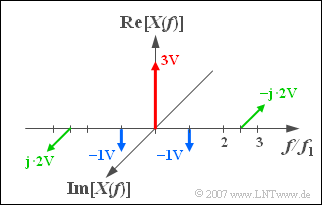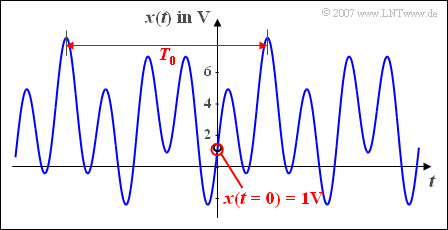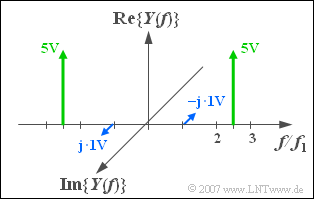Difference between revisions of "Aufgaben:Exercise 2.3: Cosine and Sine Components"
From LNTwww
| (One intermediate revision by the same user not shown) | |||
| Line 3: | Line 3: | ||
}} | }} | ||
| − | [[File: P_ID278_Sig_A_2_3neu.png|right|frame|Spectra of cosine and sine components]] | + | [[File: P_ID278_Sig_A_2_3neu.png|right|frame|Spectra of DC, cosine and sine components]] |
Given is the amplitude spectrum $X(f)$ of a signal $x(t)$ according to the graph. | Given is the amplitude spectrum $X(f)$ of a signal $x(t)$ according to the graph. | ||
| Line 57: | Line 57: | ||
===Solution=== | ===Solution=== | ||
{{ML-Kopf}} | {{ML-Kopf}} | ||
| − | |||
'''(1)''' The time signal has the following form: | '''(1)''' The time signal has the following form: | ||
:$$x(t)={\rm 3V}-{\rm 2V}\cdot \cos(\omega_{\rm 1} \cdot t)+{\rm 4V} \cdot \sin(2.5 \cdot \omega_{\rm 1} \cdot t).$$ | :$$x(t)={\rm 3V}-{\rm 2V}\cdot \cos(\omega_{\rm 1} \cdot t)+{\rm 4V} \cdot \sin(2.5 \cdot \omega_{\rm 1} \cdot t).$$ | ||
| + | |||
| + | [[File:P_ID293__Sig_A_2_3_a.png|right|frame|Sum signal of DC, cosine and sine components]] | ||
*Here $\omega_1 = 2\pi f_1$ denotes the circular frequency of the cosine component. | *Here $\omega_1 = 2\pi f_1$ denotes the circular frequency of the cosine component. | ||
*At time $t = 0$ the signal has the value $x(t=0)\hspace{0.15 cm}\underline{=1\,\rm V}$. | *At time $t = 0$ the signal has the value $x(t=0)\hspace{0.15 cm}\underline{=1\,\rm V}$. | ||
| − | |||
| Line 74: | Line 74: | ||
From this follows $f_0 = 2{\,\rm kHz}$ ⇒ period duration $T_0 = 1/f_0 \hspace{0.1cm}\underline{= 0.5 {\,\rm ms}}$. | From this follows $f_0 = 2{\,\rm kHz}$ ⇒ period duration $T_0 = 1/f_0 \hspace{0.1cm}\underline{= 0.5 {\,\rm ms}}$. | ||
<br clear=all> | <br clear=all> | ||
| − | |||
'''(3)''' The following applies to the output signal $y(t)$ of the differentiatior: | '''(3)''' The following applies to the output signal $y(t)$ of the differentiatior: | ||
:$$y(t)=\frac{1}{\omega_1}\cdot\frac{ {\rm d}x(t)}{{\rm d}t}=\frac{ {\rm -2V}}{\omega_1}\cdot\omega_1 \cdot (-\sin(\omega_1 t))+\frac{\rm 4V}{\omega_1}\cdot 2.5\omega_1\cdot {\rm cos}(2.5\omega_1t).$$ | :$$y(t)=\frac{1}{\omega_1}\cdot\frac{ {\rm d}x(t)}{{\rm d}t}=\frac{ {\rm -2V}}{\omega_1}\cdot\omega_1 \cdot (-\sin(\omega_1 t))+\frac{\rm 4V}{\omega_1}\cdot 2.5\omega_1\cdot {\rm cos}(2.5\omega_1t).$$ | ||
| + | |||
| + | [[File:P_ID294__Sig_A_2_3_d_neu.png|right|300px|frame|Spectrum with discrete components]] | ||
*This leads to the solution: | *This leads to the solution: | ||
Latest revision as of 17:33, 17 May 2021
Given is the amplitude spectrum $X(f)$ of a signal $x(t)$ according to the graph.
- Let $f_1 = 4\,\text{kHz}$ be the normalisation frequency.
- Thus the frequencies of the signal components are $0\,\text{kHz}$, $4\,\text{kHz}$ and $10\,\text{kHz}$.
This signal $x(t)$ is at the input of a linear differentiator whose output can be represented with $\omega_1 = 2\pi f_1$ as follows:
- $$y(t)=\frac{1}{\omega_1}\cdot\frac{ {\rm d} x(t)}{{\rm d} t}.$$
Hint:
- This exercise belongs to the chapter Harmonic Oscillation.
Questions
Solution
(1) The time signal has the following form:
- $$x(t)={\rm 3V}-{\rm 2V}\cdot \cos(\omega_{\rm 1} \cdot t)+{\rm 4V} \cdot \sin(2.5 \cdot \omega_{\rm 1} \cdot t).$$
- Here $\omega_1 = 2\pi f_1$ denotes the circular frequency of the cosine component.
- At time $t = 0$ the signal has the value $x(t=0)\hspace{0.15 cm}\underline{=1\,\rm V}$.
(2) The basic frequency $f_0$ is the greatest common divisor
- of $f_1 = 4{\,\rm kHz}$
- and $2.5 · f_1 = 10{\,\rm kHz}$.
From this follows $f_0 = 2{\,\rm kHz}$ ⇒ period duration $T_0 = 1/f_0 \hspace{0.1cm}\underline{= 0.5 {\,\rm ms}}$.
(3) The following applies to the output signal $y(t)$ of the differentiatior:
- $$y(t)=\frac{1}{\omega_1}\cdot\frac{ {\rm d}x(t)}{{\rm d}t}=\frac{ {\rm -2V}}{\omega_1}\cdot\omega_1 \cdot (-\sin(\omega_1 t))+\frac{\rm 4V}{\omega_1}\cdot 2.5\omega_1\cdot {\rm cos}(2.5\omega_1t).$$
- This leads to the solution:
- $$y(t)={\rm 2V}\cdot\sin(\omega_1 t)+{\rm 10V}\cdot\cos(2.5\omega_1 t).$$
- For $t = 0$ the value $y(t=0)\hspace{0.15cm}\underline{=10\,\rm V}$ follows.
- The spectrum $Y(f)$ is shown on the right.
(4) The solutions 1 and 4 are correct:
- The period duration $T_0$ is not changed by the amplitude and phase of the two components.
- This means, that $T_0 = 0.5 {\,\rm ms}$ still applies.
- The DC component disappears due to the differentiation.
- The component $f_1$ is sinusoidal. Thus $X(f)$ has an (imaginary) Dirac at $f = f_1$, but with a negative sign.
- The cosine component with amplitude ${10\,\rm V}$ results in the two Dirac functions at $\pm 2.5 \cdot f_1$ , each with weight ${5\,\rm V}$ .


